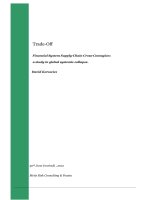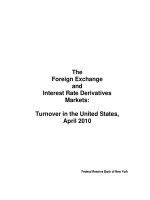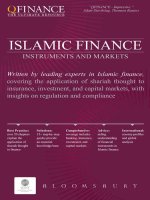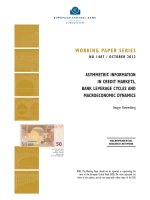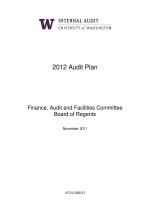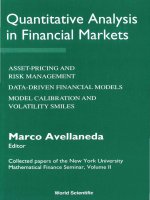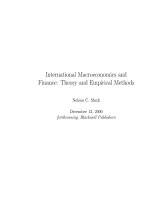pixley - emotions in finance; distrust and uncertainty in global markets (2004)
Bạn đang xem bản rút gọn của tài liệu. Xem và tải ngay bản đầy đủ của tài liệu tại đây (2.32 MB, 246 trang )
This page intentionally left blank
Emotions in Finance
Fear and greed are terms that make light of the uncertainty in the
finance world. Huge global financial institutions rely on emotional
relations of trust and distrust to suppress the uncertainties. Many
financial firms develop policies towards risk, rather than accepting the
reality of an uncertain future.
Emotions in Finance examines the views of experienced elites in
the international financial world. It argues the current financial era is
driven by a utopianism–ahope – that the future can be collapsed
into the present. It points out policy implications of this short-term
view at the unstable peak of global finance.
This book provides a timely account of the influence of emotion
and speculation on the world’s increasingly volatile financial sector.
The author includes absorbing interview material from public and
private bankers in the United States, UK and Australia.
Jocelyn Pixley is a senior lecturer in the School of Sociology and
Anthropology at the University of New South Wales, Australia. She
is the author of Citizenship and Employment.
Emotions in
Finance
Distrust and Uncertainty
in Global Markets
Jocelyn Pixley
Cambridge, New York, Melbourne, Madrid, Cape Town, Singapore, São Paulo
Cambridge University Press
The Edinburgh Building, Cambridge , UK
First published in print format
- ----
- ----
- ----
© Jocelyn Pixley 2004
© M. E. Sharpe Inc. for reproduction of p. 69
Information on this title: www.cambrid
g
e.or
g
/9780521827850
This book is in copyright. Subject to statutory exception and to the provision of
relevant collective licensing agreements, no reproduction of any part may take place
without the written permission of Cambridge University Press.
- ---
- ---
- ---
Cambridge University Press has no responsibility for the persistence or accuracy of
s for external or third-party internet websites referred to in this book, and does not
guarantee that any content on such websites is, or will remain, accurate or appropriate.
Published in the United States of America by Cambridge University Press, New York
www.cambridge.org
hardback
p
a
p
erback
p
a
p
erback
eBook (NetLibrary)
eBook (NetLibrary)
hardback
To the memory of my parents, Lorna and Neville Pixley
Contents
Figures viii
Interviews 2000–2002 ix
Preface xiii
Abbreviations xv
1Global Markets or Social Relations of Money 1
2Emotion in the Kingdom of Rationality 17
3 The Financial Media as Institutional Trust Agencies 43
4Emotions in the Boardroom 67
5Credibility and Confidence in the Central Banks 94
6Hierarchies of Trust 113
7Overwhelmed by Numbers 133
8 The Time Utopia in Finance 157
9Implications: Emotions and Rationality 183
References
209
Index 219
vii
Figures
4.1 Determinants of the State of Expectation page 69
4.2 Role of Emotions in Expectations and Decision-making 70
viii
Interviews 2000–2002
FORMER CENTRAL BANKERS
NewYork – Washington DC, February–March 2002
Alan Blinder: former Vice Chairman of the Board of Governors of the US Federal
Reserve System (1994–96); now Professor of Economics, Princeton University, NJ
Lyle Gramley: former Governor of the US Federal Reserve System (1980–85); then
at Mortgage Bankers Association of America, Washington DC
UK, March 2002
Sir Alan Budd: former Chief Economist for HM Treasury (1991–97), and former
Chief Economist of the Bank of England, also former member Monetary Policy
Committee (1997–2000); now Provost, Queen’s College, Oxford
The late John Flemming: former Chief Economist (1984–91) and Executive
Director (1988–91) of the Bank of England; then Warden of Wadham College,
Oxford
Charles Goodhart: former Chief Adviser, Bank of England, former member of the
Bank of England’s Monetary Policy Committee (1997–2000); now Professor of
Banking and Finance at the London School of Economics
Canberra, August 2001
B. W. Fraser: former Governor, Reserve Bank of Australia (1989–96); now board
Director, Members Equity and Industry Super. Second interview, 29 June 2002
FINANCIERS AND BANKERS
London
Henry Dale: former banker for fifteen years at Crown Agents, October 2000
ix
x INTERVIEWS 2000–2002
Michael Lazar: formerly de Broe, then Schr
¨
oder’s, stockbrokers (1980s); also HM
Tr easury (to 1994), June 2001. Second Interview, March 2002
Roderick Chamberlain: Coutts Consulting Group; formerly securities broker in
the Royal Bank of Canada, Nomura International; Trustee (from 1987) then Chair
(1997–2000) of the Institute of Business Ethics, March 2002
TimShepheard-Walwyn: formerly Bank of England, then Securities and Invest-
ment Board; former Head of Risk Management at SBC (now UBS), also Barclays
Bank, March 2002
NewYork and Pennsylvania 2001–2002
Henry Ouma: former Managing Director of Investments, UN Pension Funds,
NYC, May 2001
Henry Kaufman: former Vice-President, Salomon Inc. ‘Dr Gloom of Wall Street’.
NYC, May 2001. Second Interview, February 2002
Chia Sieu Wong: former investment manager for sixteen years with a large Wall
Street investment firm and other investment firms. NYC, May 2001
John Bogle: Founder and former CEO of Vanguard Group of Mutual Funds;
Valley Forge, PA, March 2002
Sydney, February 2002
John Edwards: Chief Economist, HSBC, Australia and New Zealand and former
Senior Adviser, economic (1991–94) to the Prime Minister of Australia, Paul
Keating.
Z
¨
urich, Switzerland April 2002
Dr Werner Frey: former CFO and Director Bankleu, and then Credit Suisse; now
Management Consultant, Ramistrasse 36, Z
¨
urich
Paul Chan: Managing Director, Group Risk Analysis, UBS AG Financial Services
Group, Bahnhofstrasse 45, Z
¨
urich
Georges Schorderet: CFO Swiss Air; formerly CFO Alusuisse Lonza, Z
¨
urich
FINANCE JOURNALISTS
NewYork City, September 2000
Alan Abelson: Former editor, now lead columnist, Barrons, the Dow Jones
Business and Financial Weekly. Second interview, May 2001
James Grant: Publisher-editor Grant’s Weekly Interest Rate Observer;regular finance
commentator on CNN and panellist on Wall Street Week
Anya Schiffren: Former reporter for DowJones; then Industry Standard,nowat the
School of Public Affairs, Columbia University
INTERVIEWS 2000–2002 xi
Brian Hale: Wall Street correspondent, Sydney Morning Herald and The Age
(formerly, later for The Times).
Daniel Kadlec: Finance journalist, Time Magazine,February 2002
London
Larry Elliott: Economics editor, The Guardian,October 2000
Dominic Ziegler: Finance editor, The Economist,March 2002
Graham Ingham: formerly with the BBC; now economic journalist, The Economist,
March 2002
Robert Peston: Former finance editor, the Financial Times;now finance columnist,
NewStatesman.Telephone Interview, London March 2002
Sydney, January 2000
Tr evor Sykes: Senior journalist, Australian Financial Review and ‘Pierpont’ column.
V. J. Carroll: Former editor, Australian Financial Review from 1964; former editor-
in-chief, Sydney Morning Herald until 1984. Second interview, January 2001.
FINANCIAL PUBLIC RELATIONS
Jonathan Birt: Financial Dynamics Business Communications, Holborn Gate,
London. March 2002.
CONFIDENCE SURVEY ANALYSTS
KenGoldstein: Economist, The Conference Board, 845 Third Avenue. New York,
February 2002
Duncan Ironmonger: Professor of Economics, University of Melbourne; Analyst
Dun&Bradstreet Expectation Surveys. Sydney, December 2001
Preface
HOW I CREATED the precise idea of Emotions in Finance is the
only event I cannot recall. My background in economic sociology led to some
useful discoveries about the finance world. My work defending full employment
and social policy was a bore to my postmodern colleagues and beneath contempt
to neo-classical economists. From 1996, Australia’s new right-wing government
stifled policy debates: instead of decent employment we were to join a mainly
Anglo-American society of shareholder capitalists; our compulsory superannuation
must offer ‘choice’. Globalisation, by 1997, had become a fashionable term, but I
was struck by the IMF’s treatment of our neighbour Indonesia: brutal yet totally
incompetent. Meantime, I was reading the work of two sociologists, Jack Barbalet’s
on emotions and Geoff Ingham’s on money as a social relation. Both struck a
chord just as the dot.com boom was becoming insane. I am old enough to have
experienced Australia’s ludicrous mining boom. The scrip of Poseidon and Minsec
shares bought by my former husband became pretty gift wrapping in 1971, we
joked in that carefree time of jobs and freedom. My parents were of the cautious
generation. To my mother, a mortgage was OK, better was paying it off. My father
was a ‘managing director’, not a sainted CEO of today. Each had ‘blue chip’ share
portfolios and we lived comfortably.
During the dot.com insanity, modest investors and the millions in investment
funds were blamed for their emotions. As part of my world view, I had never
been impressed by high finance’s mendacity, its promotion of globalisation and its
increasing lack of caution. Sociologists seemed captivated either by virtual money or
a financial conspiracy, but I took another view, seeing the emotions of uncertainty
as the key. Moreover, being on the periphery, Australia is a good vantage point from
which to investigate the financial core, since Australia’s business sector has copied
and amplified its excesses. But we, the people, can temper globablisation, and
instead strengthen commitments to international agreements in which economic
policy serves social purposes and democratic processes, for which Australia once
had some reputation.
Emotions in Finance was the title that attracted my two great publishing editors
at Cambridge University Press: Peter Debus who enthusiastically and carefully
xiii
xiv PREFACE
saw me through, and Phillipa McGuinness who commissioned my idea. When I
concluded, I briefly toyed with another title: High Finance, Deep Uncertainty.But
when I began, my theoretical scepticism required evidence. What were the precise
emotions that prevail? I needed ‘informed sceptics’, so I interviewed a number
of influential people in the financial world. They gave me enormous support, ar-
ranging for me to interview others, carefully correcting my transcripts and revising
their quotes (John Flemming only months before he died) and responding to my
further queries generously, Henry Dale in particular. Many whom I lacked space to
quote were also enormously helpful. I thank them all: while I am solely responsible
for my conclusions, their own wisdom and commonsense shines through.
Jack Barbalet and Geoff Ingham gave sound advice, perfect references to other
works and read the crucial chapters. Peter Kriesler has been my closest economic
advisor: reading vast chunks of early drafts and tirelessly improving my sociological
translation of Keynes. Paul Ormerod supported all my unorthodox endeavours,
suggested interview questions on probability, introduced me to Meghnad Desai,
Robin Marris and others in London. Both exceptional themselves, Carol Heimer
helped me on one path to all the best in Chicago’s economic sociology, while
June Zaccone sent me to the best New York economists. My other debt is to
V. J. Carroll, who inspired me about the urgent need for more sociological than
economic analysis in the public domain, and to Mike Lazar, similarly.
There are many others (whole households in other countries) to whom I am
grateful. Most and best of all two: my son Sam Dawson became an inadvertent
and brilliant research assistant in New York City, Chicago, London and Canberra,
at our own expense, and then my main informal editorial advisor. My daughter,
Louisa Dawson, formulated ideas for design that ultimately became the cover:
artists see while we just write. Both have firmly put up with my obsession involved
in writing any book. I had enormous collegial support from my whole School,
so while Clive Kessler found my most felicitous phrases and kept me going while
Mum was dying, and Paul Jones helped in our shared teaching and was the source
of my media understanding, everyone was great. Beyond my School, Michael
Johnson saw the whole point of my early idea for the research; Alan Morris and
Robert Milliken helped introduce me to financiers and journalists. The Faculty of
Arts and Social Sciences at my university have been helpful for years, especially
with my Writing Fellowship in 2003; so too the Australian Research Council
in grants. Antonny Ivancic provided thoughtful research work, Aileen Woo and
Louise Fraser similarly on the manuscript and transcripts, and Harry Blatterer
translated, theoretically too, entscheidungsfreudig.Venetia Somerset, as the book
neared completion, gave scrupulous copy-editing and calm intelligence to see the
book out, and while with thanks to so many, any inadvertent errors are mine.
Jocelyn Pixley
August 2004
Abbreviations
AIB Allied Irish Banks plc
AFR Australian Financial Review
AMP Australian Mutual Provident Society (Established January 1849;
demutualised January 1998)
AOL America Online
APRA Australian Prudential Regulation Authority
ATTAC Association pour une Taxation des Transactions Financi
`
eres pour l’Aide
aux Citoyens
BCCI Bank of Credit and Commerce International
BoE Bank of England
BoJ Bank of Japan
CADs Current Account Deficits
CB central bank
EBRD European Bank of Reconstruction and Development
ECB European Central Bank
EMH efficient market hypothesis
FASB Financial Accounting Standards Board (USA)
FD financial disclosure
FOMC Federal Open Market Committee (US Federal Reserve System)
FSA Financial Services Authority (UK. Established under the Financial
Services and Markets Act 2000)
FT Financial Times
GDP Gross Domestic Product
HSBC HSBC Bank Australia Limited (founded as the Hongkong and Shang-
hai Banking Corporation Limited in 1865)
HIH HIH Insurance Limited (Australian-based)
ICI Imperial Chemical Industries plc
IMF International Monetary Fund
ING ING Group (First titled Internationale Nederlanden Group in 1991)
IPO Initial Public Offering
IT information technology
xv
xvi ABBREVIATIONS
LBO leveraged buyout
LTCM Long Term Capital Management (US-based hedge fund)
MAI Multilateral Agreement on Investment (not ratified)
M&A Mergers and Acquisitions
MPC Monetary Policy Committee (Bank of England)
NAB National Australia Bank
NAIRU non-accelerating-inflation rate of unemployment
NYSE New York Stock Exchange
OECD Organisation for Economic Co-operation and Development
PR public relations
RBA Reserve Bank of Australia
REM rational economic man
S&L Savings and Loan (known also as thrifts, US mutual savings banks)
S&P Standard and Poor’s (US-based credit-rating agency)
SEC U.S. Securities and Exchange Commission
SMH Sydney Morning Herald
UBS Union Bank of Switzerland (UBS AG since 1998)
WTOWorld Trade Organization
1
1
Global Markets or Social
Relations of Money
ECONOMIC POLICIES AIMING to defend money as a store of
value have prevailed for thirty years over postwar attempts at social democracy.
It is a complex story of the financial sector regaining some of its former policy
control, which had been lost in the national and international initiatives of the
1930s and 1940s, from the New Deal to Bretton Woods, to overcome the Great
Depression. Those interventionist policies sought to alleviate economic uncertainty
and its attendant shocks; the current anti-inflationary policies attempt to reduce
the uncertainty of money’s value as a financial asset. But, as this study argues,
uncertainty is not only inevitable in economic activity generally but is magnified
in finance because money is based on a trust that is inherently problematic.
Uncertainty is unavoidable. Squeezed in one place, it emerges in another. After
the postwar welfare state compromises to sustain full employment were disbanded,
even Federal Reserve Chairman Greenspan admitted this, behind closed doors in
1996. He said ‘product price’ inflation can be conquered only at the cost of price–
earnings ratios going ‘through the roof ’ (quoted page 111). Recurrent speculative
booms and busts bring debt-deflation in their train, historically a common phe-
nomenon. Defenders of economic orthodoxy often argue that asset inflation results
from emotional intrusions into a rational world. But emotions are unavoidable.
Rational calculations can be based only on the past. Instability continually arises,
especially when money is treated as a financial asset. Money entails claims and
credits, and so presumes social relations created from prospective and therefore
unknowable promises. Secure rational calculation can only be retrospective; it
cannot see or reach beyond the horizon separating the future from the present. Yet
financial firms, banks and, increasingly, non-financial firms these days trade ever-
proliferating claims to future income, creating more debt and more uncertainty.
Uncertainty can only be dealt with by emotional projections and, since finance is
a vital part of economic activity, the fundamental role of emotions deserves serious
analysis.
This book looks at the ‘financial heartland’, the major institutions where money
is controlled and traded as though it were a predictable commodity. It is not. ‘The
money power’, as British Prime Minister Gladstone termed it, is more mundane
1
2 EMOTIONS IN FINANCE
than its jargon implies. Central banks issue the most trustworthy, most accepted,
‘high-powered’ money; these monetised debts rely on trust in government debts,
as we will see. Yet since the idea of money as ‘promise’ is counter-intuitive, going
against the everyday experience of its tangibility in our hands and wallets, most
critics neglect the implied promise that money entails and so leave unexamined the
trust on which it rests. Instead they argue that greed drives the City of London or
Wall Street. This book, in contrast, argues that finance is inherently emotional, and
that specific emotions in finance arise from the radical uncertainties of money. Since
promises are of uncertain reliability, distrust, sometimes fear, inspires all financial
action. This is confirmed by the experience and words of the informed sceptics
whose interviews form the basis of this book.
WHY EMOTIONS?
I start from the idea this world is driven by a combination of emotions and
rationality – not personal or private emotions, and not greed per se. In finance
uncertainty is masked (disguised as ‘risk’, not losses). It cannot be spoken, for it is
the unsayable. Since uncertainty about claims is always extreme, decisions rely on
future-oriented emotions. Competitive financial firms live and die upon predicting
future outcomes which are unknowable, no matter how rational their calculations
of past information. Therefore, firms must project emotions and conventions about
the unknowable future and, through strategies of a pseudo-rational kind, bring
these conjectures back to the present in order to act. The typical emotions are trust
and distrust, whereas the typical convention is to assume that the future will resem-
ble the past. These are the inevitably shaky, emotional foundations of finance.
Financial life publicly revels in greed and risk today because these are exciting;
inherent unknowability is duller, though fraught. No one knows the future. Each
area (from banking to insurance) has its own definitions of risk; however, rarely is
the gulf between the future vista (in the jargon, ‘expectations’) and the inevitable
lack of knowledge of the future made explicit. It hides in the ‘fine print’ or ceteris
paribus escape clause. As they seek to face uncertainty rationally, huge organisations
are driven by trust and distrust. Firms explicitly admit this. Although their in-house
jargon is about anonymous markets, the call to ‘Trust Us’ is implicit in their names.
You, sweet investor, are ‘made free’ by your control over your money.
Yet inside this world, financial firms can barely control all their promises to pay
each other. Star CEOs, not just the public, are confused by the latest financial
‘product’. Inside this world firms do not know their own (future) interests. They
extoll competition and insist on complete freedom from government supervision,
at the very moment when they are going bankrupt or collapsing from chains of
corruption that are often, as we will see, weirdly unintended because unimagined.
Both orthodox and Marxian economics assume that rational interests drive the
world. Their insistence on this claim reduces all of social life to the economy.
But integral to all financial interrelations is a deep uncertainty which unavoidably
involves emotions, which are often powerful and usually unperceived.
GLOBAL MARKETS 3
Central banks try their honest, public service best, but private banks and financial
experts demand they be ‘credible’ in monetising public debt. Governments require
them to maintain stability, yet central banks must present government promises as
credible to private creditors. What is credibility? No sooner do credibility and trust
appear newly stable and deserving of confidence than some new and unforeseen
factor intrudes, and genuinely trustworthy reputations are destroyed. As this book
shows, these inter-organisational relations of trust and distrust among major
institutions involve emotions, which fuel demands for, and even promises of,
‘risk-free’ money. At each failure, this trust collapses into fear, and mistrust calls
forth new futile quests for control over the future. The emotions born not of
personal desire but of the unknowability of the future drive economic life as much
as does rational calculation.
AMBIGUOUS TRUST IN THE
IMPERSONAL MARKET
In the wake of economic crisis and collapse, the losers are so quickly forgotten. To
the financial world view, the catastrophic effects on whole countries of speculation
on future claims are merely passing tragedies. From a democratic viewpoint, rela-
tions of money are in principle important and could be fine in moderation – so long
as they are restrained by democratic regulation and oversight. Caution is the key
emotional term. But the ‘money power’ has never faced democratic control beyond
the flimsy post-1945 controls on capital movements and ‘fixed’ exchange rates – in
contrast to today’s uninhibited selling and buying of currencies that float on forex
markets – and serious prudential regulations. Yet wild as the numerous financial
markets may seem, the Anglo-American financial world is not ‘evil personified’.
Such talk is extremely dangerous. The racist personifications and scapegoating that
were so characteristic of our modern world’s murky past were opportunistically
resurrected by Malaysia’s Dr Mahathir during the Southeast Asian crisis of 1997.
As we will see, modern finance is increasingly abstract, impersonal and imprudent.
Competitive policies drive cautious and foolish banks to the wall. This is my
focus, not any conspiracy in finance nor, in contrast, whether the millions individ-
ually involved on the periphery are willing punters or reluctant, fearful investors.
Indeed, gambling is far more predictable than financial speculation (since losses
are openly inevitable), and billions more people gamble than play the financial
markets.
Money continually generates financial crises and when it does it is not ‘markets’
that are the target of those whose trust has been abused and their savings and houses
lost. Rather, the victims correctly specify and loathe commercial (retail) banks or
merchant banks, insurance firms or mutual funds across the USA, Europe, the
UK, Japan and peripheral countries. Through their public relations efforts these
financial institutions are unable honestly to convince people of their probity and
innocence. So, as its critics tirelessly recount, ‘money power’ has far more effec-
tive recourse to political lobbying and donations by the peak investment banks,
4 EMOTIONS IN FINANCE
accountancy firms and commercial banks. Though such strategies can backfire,
financial power also wields strong if often unseen weapons against those, espe-
cially democratically elected legislators, who might aspire to restrain its operations
by statutory regulation and oversight. Downgrading of public creditworthiness,
hostile mergers and capital ‘flights’ are rightly feared. These measures may silence
democratically elected governments and so demean the political process. While
unemployment also results, it is financial losses among middle-income groups of
creditors or debtors that often prove a more frightening sword suspended over
governments.
The focus of this present analysis is on the forgotten element – the necessity,
and the inescapable insecurity, of ‘trust’ and its emotional consequences – within
this mysterious world of the financial heartlands; it is not on whether individuals
are willing punters or on the operation of markets per se. Financial organisations
are unavoidably involved in impersonal relations of trust and distrust. But can
routine projections of trust and distrust help to counteract uncertainty, to foster
institutional guarantees for the chimera of risk-free money, and to ensure trustwor-
thy reputations? Trust and confidence help to reduce perceptions of uncertainty
in financial decisions, but when they foster arrogance, then abuse and collapse,
they can easily inspire fear of failure, of financial losses, or of loss of institutional
reputation. Trust is an emotion best recognised when it turns into the opposite. In
moments of crisis the trust that is intrinsic to financial life may be suddenly trans-
muted into blame and rage. This book is primarily concerned with the ambiguous
nature of this neglected ingredient, trust. In its argument the larger questions about
values, democracy and socially beneficial compromises are noted in passing. The
practical imperatives of understanding emotions in finance are too important and
too misunderstood to be left off the public agenda. Impersonal trust and distrust
relations are inherent in modernity, and the trust in money is extraordinarily
ambiguous.
Certainty about the economic future is a mirage. To help us cope with its
unattainability, to soften the pain born of our ignorance, we put our trust in trust.
Yetbydoing so, by thrusting trust forward as a bulwark against the unacknowledged
implications of uncertainty, we expose and even undermine our trust in trust itself.
Our enforced reliance on trust makes trust itself increasingly insecure, fraught and
unreliable. We chop off the branch to which we are ever more desperately clinging.
So the quest for certainty is futile. And even though recognising its existence,
uncertainty must remain unacknowledged by financial organisations, no matter
how competent and honest.
John Maynard Keynes makes a major contribution in linking uncertainty to
emotions, but his analysis, like many others, started with individual psycholog-
ical feelings. That is an unhelpful point of analytical departure. To begin with
individuals – lone, powerless natural persons who face a world of large organ-
isations in chains of relationships about promises – diverts the analytical focus
from those chains of relationships and the institutional world in which they are
formed and sustained. And when individuals lose, they are cast as consumers in
markets on the ‘buyer beware’ principle. Many may even experience shame for
GLOBAL MARKETS 5
losing, for having been ‘conned’, for being stupid. Yet the problem lies not in
individual miscalculation or in any personal misplacing of trust; its source lies in
those chains of impersonal trust between large financial organisations and in those
controlling them. This sense of personal shame, funnily enough, may also apply
to those individuals formally enmeshed within this rarefied world of high financial
strategising.
BEYOND ORTHODOXY: THE REALITY
OF UNCERTAINTY
My book takes existing financial organisations as historically given, questioning
only a few key ‘events’ which shaped or institutionalised specific ways of acting
towards the future. It explores how ‘social emotions’ – those that are inherent
within certain institutional complexes – generate expectations in financial deci-
sions and negotiations between these vast organisations of finance. The analy-
sis offered is inspired by sociology, but it draws on the Keynesian tradition in
work such as Hyman Minsky’s and on perceptive interpreters of Keynes such as
G. L. S. Shackle. While it is armed with the Keynesian concept of uncertainty, it
offers an explicitly social approach to exploring the ways that trust and distrust
are projected, not by the supposedly isolated investors but by organisations, in
formulating decisions that may enjoy a semblance of rational conviction.
While this account challenges orthodox economics, its central concern is to
investigate trust relationships. It neither debates the abstractions of theoretical eco-
nomic orthodoxy nor covers the immense detail about institutional structure and
evolution that are ably marshalled by political scientists and economic historians
such as David Kynaston (1994, 1995) and Glyn Davies (1994) in Britain alone. So
too, there are national variations in corporate law and financial regulations. While
an enormous specialist literature details every global financial transformation in
each country, this study draws on US and UK experiences, with their so-called
capital market or ‘exit’-type practices (Cerny 1993; Helleiner 1993; Grahl 2001).
Butnoinstitutional description of ‘what is’ can ever predict the future, regardless
of whether finance is purely ‘global markets’ or whether national governments
and major social groups might resume a democratic role in financial supervision.
Since the future is unknowable, and the implications of its unknowability may be
terrifying, attention must be paid to the emotions surrounding uncertainty that
enable decisions to be made.
When I began this research, many social scientists, not to speak of the public
at large, seriously underestimated the extent to which financial organisations rely
on impersonal trust and confidence. Keynesian ‘uncertainty’ was long forgotten.
By 1999, the climate of optimism was high, and it was extraordinarily difficult to
suggest that stock market excitement for a ‘new economy’ of internets and e-mails
was about impersonal trust. Some perceptive people thought I was onto an unusual
and worthwhile idea, but many looked at me in disbelief: they could not imagine
that all their money was resting, as usual, on a flimsy edifice of mere emotions.
Several years of ensuing scandals brought widespread lack of trust, yet my focus
6 EMOTIONS IN FINANCE
is not so much on the frauds because there are books on every scandal. Rather, I
look at the insecurity inherent in the procedures the financial world employs to
master the unknowability of the future, and the volatile emotions entailed in its
futile quest.
Orthodox economists tend to dismiss sociology for dealing with the ‘residue of
“irrationality”’ or ‘tosh’ (cited in Ingham 1996b: 224–5). The claims of economic
orthodoxy appear to me suspect for a number of reasons. These economists see only
risk, not uncertainty; they see money as neutral in the long run; and they regard
financial crises as emotional or irrational ‘intrusions’ into the ‘real’ goods-and-
services economy. Anonymous market actors are said to act rationally in response
to purely economic signals and indicators, while remaining detached and abstracted
from the influence of social relations, whether with groups or with organisations.
This is an unsustainable view also acknowledged in institutional economics which,
following Thorstein Veblen as well as Joseph Schumpeter, shows how institutions
have developed precisely to deal with uncertainty. The ‘rational economic actor’
does not exist in the complexity of actual social life. Real, living human beings come
first, and the economic actor is a simplified abstraction from what they do. Humans
only become human through their relationships. Less orthodox economists are now
becoming increasingly sensitive to this fact and its implications, especially through
dialogue with other social scientists. They now recognise that their discipline’s
received wisdom has been as much a source of social problems as any cure for
them. Many economists, from recanters to non-believers, now criticise the decades
of neo-classical hegemony over public policies, while among academic economists
its social irresponsibility and lack of intellectual credibility are exposed. As the
supposed ruling monarch of the social sciences, economics has not only been
revealed as an emperor with no clothes; its role in keeping clothes from the backs
of so many living, real people is also becoming ever clearer.
This book trespasses only lightly on economic turf. Unlike many critiques of
economic orthodoxy which rarely move beyond the endless point-scoring that
never convinces the faithful, this work neither engages centrally with received
economic wisdom nor employs it as a foil for the display of an alternative analysis
to that offered by mainstream economics. Rather, it strategically plunders conven-
tional economics in order to raise for public debate issues that lie beyond its own
intellectual assumptions and horizon.
MONEY: A SOCIAL RELATION OF DEBTS
AND PROMISES
The term ‘financial markets’ highlights a broad contrast between the present and
postwar era, when money and finance played a less prominent role than giant manu-
facturing corporations, bureaucracies and public institutions. As late as the 1970s,
so a consensus across the political spectrum held, a ‘central and distinguishing’
feature of the modern social world was that it was ‘a world of organizations’ (Burns
1974: 123). That view was soon sidelined, partly by theoretical criticisms and
GLOBAL MARKETS 7
partly by substantive economic changes. The key term was now ‘market’, which
some saw as synonymous with ‘democracy’.
Like those in the area of production, the relationships of money constitute a
huge world of organisations. However, financial organisations are very different
from the old corporate firms (though they too now invest heavily in financial assets,
offer customer credit, and use pension funds). Money is different from commodity
and service production, because it magnifies uncertainty. Money is also produced
differently. It is debatable whether money is a commodity at all, since it is created
from debt relationships. The money in our wallets and purses is part of an abstract
chain of social relations of claims and credits, no less organised than plastic card
money and bank mortgages. In many ways, money is one of the most enigmatic of
social institutions (Wennerlind 2001: 557) because it is ‘worthless unless everyone
believes in it’ (Greider 1987: 226).
The idea of money as an enigmatic social institution and social relation is
counter-intuitive – and one that is far less understood today than in earlier eras.
Money is highly ‘productive’. Differing political views of capitalism, such as those
of Keynes and Schumpeter, emphasise the major role money plays in capital-
ism. Schumpeter argued that money is the internal engine driving capitalism (e.g.
1954: 318). Even though orthodoxy uses him to focus narrowly on the heroic en-
trepreneur, it is finance as the ‘gatekeeper of development’ that allows Schumpeter’s
debtor-entrepreneur to act or not (Tobin 1987: 164; Ingham 2004: 201). Georg
Simmel’s classic text Philosophy of Money similarly draws enthusiastic attention to
money’s enormous ‘productive power’, not from owning or hoarding money but
from ‘the money yielded by money’ (Simmel 1978: 182). This underestimated but
dynamic role explains the instability of money.
All contemporary economists accept that money arises from the debt struc-
ture. How? Perhaps because it is counter-intuitive, or even alarming, orthodox
economists underestimate the importance of this main premise. They see money
as, in the long run, neutral. This view of money as a veil, as mainly barren, underlies
all neo-classical views. But this argument is maintained by focusing on one of the
functions of money that everyone knows – the one that seems to make sense of
our daily experience of exchange. In performing its ‘exchange function’, money
seems easier to use than bartering with a mass of different, cumbersome goods or
services. When seen as a handy device, money appears relatively unimportant: as
merely a medium, as a passive instrument for simplifying exchange. In this view, if
money can be said to do anything at all, then all it does is to send messages about
‘real’ activities in the ‘real’ economy, in its price signals. Schumpeter demolished
this view long ago: ‘you cannot ride on a claim to a horse, but you can pay with a
claim to money’; banks are ‘merchants of debt’ (Schumpeter 1954: 321; Minsky,
cited in Ingham 2004: 161).
Money is created from the debt structure and its promise has two dimensions. In
one sense, money is a promise or claim of ‘payment’ in something (Schumpeter’s
point) – an alienated, exchangeable promise. In its credit dimension, money is
apromise to creditors about the borrower’s ability to discharge a debt and the
